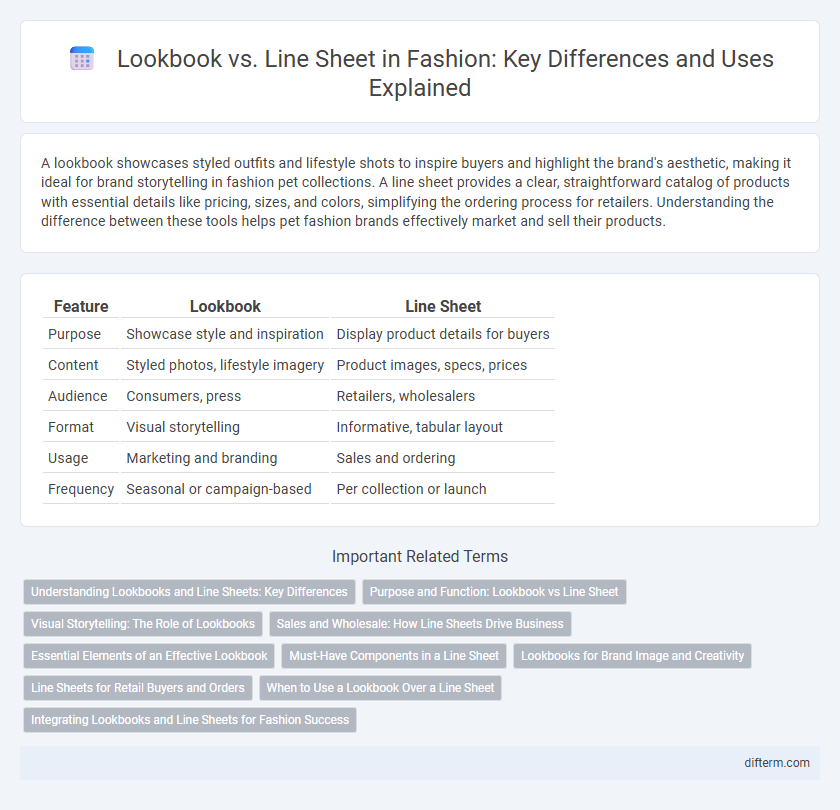A lookbook showcases styled outfits and lifestyle shots to inspire buyers and highlight the brand's aesthetic, making it ideal for brand storytelling in fashion pet collections. A line sheet provides a clear, straightforward catalog of products with essential details like pricing, sizes, and colors, simplifying the ordering process for retailers. Understanding the difference between these tools helps pet fashion brands effectively market and sell their products.
Table of Comparison
| Feature | Lookbook | Line Sheet |
|---|---|---|
| Purpose | Showcase style and inspiration | Display product details for buyers |
| Content | Styled photos, lifestyle imagery | Product images, specs, prices |
| Audience | Consumers, press | Retailers, wholesalers |
| Format | Visual storytelling | Informative, tabular layout |
| Usage | Marketing and branding | Sales and ordering |
| Frequency | Seasonal or campaign-based | Per collection or launch |
Understanding Lookbooks and Line Sheets: Key Differences
Lookbooks showcase styled outfits and brand aesthetics through high-quality images, serving as visual inspiration for buyers and consumers. Line sheets present detailed product information, including pricing, sizes, and materials, to facilitate wholesale ordering. Understanding these differences helps fashion professionals effectively communicate their collections and streamline sales processes.
Purpose and Function: Lookbook vs Line Sheet
Lookbooks serve as a visual marketing tool designed to showcase a brand's aesthetic, style, and seasonal collections through styled imagery, inspiring buyers and customers with lifestyle context. Line sheets function as practical sales documents listing detailed product information, including SKU numbers, pricing, sizes, and order minimums, aimed at facilitating wholesale purchasing decisions. While lookbooks emphasize brand storytelling and visual appeal, line sheets prioritize clear product data and transactional efficiency for buyers.
Visual Storytelling: The Role of Lookbooks
Lookbooks serve as powerful tools for visual storytelling in fashion, showcasing a brand's aesthetic and mood through styled photography that captures the essence of a collection. Unlike line sheets, which focus on detailed product information such as SKUs, pricing, and specifications, lookbooks emphasize narrative and emotional connection to inspire buyers and consumers. This visual storytelling approach enhances brand identity, making lookbooks essential for creating memorable and engaging fashion presentations.
Sales and Wholesale: How Line Sheets Drive Business
Line sheets serve as essential sales tools in wholesale fashion, providing buyers with concise product details such as pricing, sizes, and order quantities that streamline purchasing decisions. Unlike lookbooks, which primarily inspire brand aesthetic and creativity, line sheets prioritize clear, actionable information that accelerates transaction processes and enhances business communication. Efficient line sheets help brands increase order volume, foster retailer relationships, and drive consistent revenue growth in competitive wholesale markets.
Essential Elements of an Effective Lookbook
An effective lookbook showcases high-quality images that highlight the apparel's fit, fabric, and style, serving as a visual story for buyers and consumers. Essential elements include clear and consistent branding, detailed styling notes, and versatile layouts that enhance the presentation of each piece. Incorporating diverse model representations and seasonal themes further elevates the lookbook's appeal and market relevance.
Must-Have Components in a Line Sheet
A line sheet must-have components include clear product images, detailed descriptions, pricing information, and available sizes or colors to ensure buyers have all necessary details. Contact information and order minimums are essential for streamlining communication and purchase processes. Unlike lookbooks, line sheets prioritize concise, transactional data aimed at facilitating wholesale orders.
Lookbooks for Brand Image and Creativity
Lookbooks serve as a powerful visual tool to elevate a brand's image by showcasing styled outfits that convey the designer's creative vision and lifestyle aesthetics. Unlike line sheets, which focus on product details and wholesale information, lookbooks emphasize storytelling through curated photography, mood, and style, making them essential for brand identity and consumer engagement. High-quality lookbooks create emotional connections and inspire customers, reinforcing brand loyalty and recognition in competitive fashion markets.
Line Sheets for Retail Buyers and Orders
Line sheets serve as essential tools for retail buyers by providing clear, concise presentations of a fashion brand's products, including detailed information such as pricing, fabric composition, SKU numbers, and order minimums. Unlike lookbooks, which emphasize creative visual storytelling, line sheets prioritize functionality and ease of order placement, streamlining the buying process for wholesale transactions. This efficiency helps retailers make informed purchasing decisions quickly, optimizing inventory selection and sales potential.
When to Use a Lookbook Over a Line Sheet
Use a lookbook over a line sheet when showcasing seasonal styling, brand story, and outfit inspiration to attract retailers and consumers emotionally. Lookbooks highlight lifestyle imagery and curated looks, making them ideal for marketing campaigns and fashion editorials. Line sheets serve best for straightforward product details and wholesale ordering but lack the visual narrative that lookbooks provide.
Integrating Lookbooks and Line Sheets for Fashion Success
Integrating lookbooks and line sheets creates a cohesive marketing strategy that showcases a brand's vision and product details effectively. Lookbooks highlight styled outfits and lifestyle imagery to inspire buyers, while line sheets provide essential product information, pricing, and ordering instructions crucial for wholesale transactions. Combining these tools enhances brand storytelling and streamlines communication with retailers, driving fashion sales growth.
Lookbook vs Line sheet Infographic

 difterm.com
difterm.com